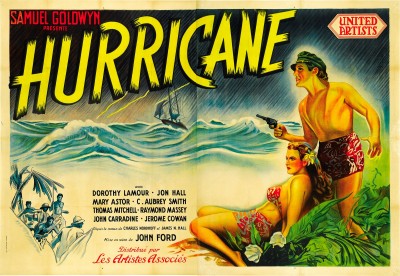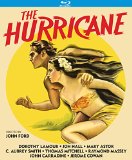| Reviews & Columns |
|
Reviews DVD TV on DVD Blu-ray 4K UHD International DVDs In Theaters Reviews by Studio Video Games Features Collector Series DVDs Easter Egg Database Interviews DVD Talk Radio Feature Articles Columns Anime Talk DVD Savant Horror DVDs The M.O.D. Squad Art House HD Talk Silent DVD
|
DVD Talk Forum |
|
|
| Resources |
|
DVD Price Search Customer Service #'s RCE Info Links |
|
Columns
|
|
|
Hurricane (1937), The
Overseen by A-list producer Samuel Goldwyn at a reported cost of $2 million (making it one of the ten or so most expensive films up to that time), The Hurricane set the standard for South Seas adventures for the next couple of decades, more so even than MGM's earlier Mutiny on the Bounty (1935), likewise based on a novel by James Norman Hall (Jon's uncle) and Charles Nordhoff. Stars Jon Hall and Dorothy Lamour became typed for similar productions, he in a series of lavish Technicolor fantasies at Universal, she as the "Sarong Girl" at Paramount, sometimes to comic effect, teamed as she often was with (Bob) Hope & (Bing) Crosby. Dramatically though, The Hurricane has an impressively sturdy script by Dudley Nichols and Oliver H.P. Garrett and a superb supporting cast.
A schooner drops anchor on the Polynesian island of Manukura, with Captain Nagle (Jerome Cowan) at the helm. One of the passengers is Germaine (Mary Astor), the wife of Eugene DeLaage (Raymond Massey), the island's French colonial governor and a martinet.
Also aboard is Nagle's first mate, handsome and popular native Terangi (Jon Hall), who weds Marama (Dorothy Lamour), island Chief Mehevi's (Al Kikume) daughter, later that same day. Everyone attends the happy ceremony, presided by Father Paul (C. Aubrey Smith) and including Dr. Kersaint (Thomas Mitchell).
Following an idyllic honeymoon on the adjacent though uninhabited island of Motu Tonga, Terangi returns to Nagle's schooner, bound this time for Tahiti. There, he breaks a (white) man's jaw while acting in self-defense, yet unjustly receives a six-month jail sentence passed by DeLaage and due to the white man's powerful connections. Sent to a brutal labor camp, multiple escape attempts add years to his sentence. Terangi's friends, white and native, attempt to intervene, but DeLaage will not budge.
Like a providential intervention, the winds begin to pick up and….
The Hurricane's special effects cost $400,000, several times the cost of 90% of entire feature films made during this time. Mostly a combination of full-size physical effects featuring the cast and stunt people and large miniature sets, the work is still pretty stunning, having the organic quality completely lost in today's CGI. Goldwyn may have aspired to one-up the set pieces of RKO's The Last Days of Pompeii (1935, from most of the King Kong team) and MGM's San Francisco (1936), whose dazzling earthquake sequence reportedly was supervised by D.W. Griffith. The typhoon in The Hurricane is at least as impressive.
Yet, unlike the vast majority of disaster films, Ford and Nichols particularly create an audience-involving, intimate epic, a personal story damning colonial rule over native people better off without "civilization." Though forward thinking in one sense, this is a theme common in many of the MGM (and, later, RKO) Tarzan films of the time. In those films white outsiders are at best well-meaning troublemakers, who disturb a carefully balanced paradise.
The influential film can be forgiven its island paradise clichés mainly because Ford and Nichols are clearly on the side of the native islanders. Though less realistic than, say, MGM's earlier Mutiny on the Bounty, it's a dream-like fantasy Ford pulls off. Indeed, The Hurricane is one of Ford's most under-valued films.
Video & Audio
Filmed in black-and-white and presented in its original 1.37:1 standard ratio, The Hurricane looks fabulous, far superior to the 16mm TV prints from which many of us first saw the film broadcast. Contrast, blacks, etc. are impressive and, oddly, the miniature effects actually look more impressive with the added clarity of HD, especially on big home theater screens. The 2.0 English mono, DTS-HD Master Audio, is also way above average. No subtitles or alternate audio options.
Extra Features
Other than the usual trailer, there's just one extra, but it's an especially good one: an excellent, well-researched audio commentary by John Ford authority Joseph McBride. He does an exceptionally fine job putting the film into context, aiding in the viewer's enjoyment.
Parting Thoughts
An extremely polished, still incredibly entertaining epic, The Hurricane is Highly Recommended.
Stuart Galbraith IV is the Kyoto-based film historian and publisher-editor of World Cinema Paradise. His new documentary and latest audio commentary, for the British Film Institute's Blu-ray of Rashomon, and commentary track for Arrow Video's Battles without Honor and Humanity are newly available.
|
| Popular Reviews |
| Sponsored Links |
|
|
| Sponsored Links |
|
|
| Release List | Reviews | Shop | Newsletter | Forum | DVD Giveaways | Blu-Ray | Advertise |
|
Copyright 2024 DVDTalk.com All Rights Reserved. Legal Info, Privacy Policy, Terms of Use,
Manage Preferences,
Your Privacy Choices | |||||||














